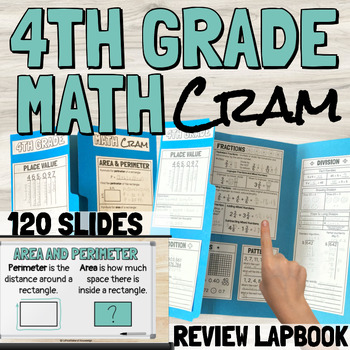4th Grade EOG Math Review Slides Study Guide End of Grade Common Core Test Prep
- PDF
- Google Apps™

What educators are saying
Description
Review an entire year of fourth grade math in just one week with this cram activity! This resource includes 120 Google Slides that review CCSS 4th grade math standards and walk students through constructing a lapbook study guide that they can use to prepare for end of grade testing (EOG/EOY). This activity is the perfect way to easily review math concepts at the end of the year or for remediation and retesting.
Skills covered include:
- Place value - up to 6 digit numbers, standard, expanded, word form, rounding
- Area and perimeter of rectangles
- Addition and subtraction - up to 6 digit numbers standard algorithm
- Multiplication - up to 2 digit x 2 digit
- Division - basic division, long division
- Fractions - equivalent, comparing, improper fractions & mixed numbers, adding with like denominators, whole number times fraction
- Decimals - tenths and hundredths
- Patterns - shape and number patterns
- Geometry - lines and angles, triangles, quadrilaterals, angle measurement, symmetry
- Measurement - metric and customary units, elapsed time, fraction line plots
This download includes:
- 120 Google Slides
- a teacher's guide
- 4 printable lapbook pages
- 4 pre-filled lapbook pages
Please follow my store here for more great resources!
You can also find me on Facebook, Instagram, and lafountaineofknowledge.com where you'll discover ideas, inspiration, and plenty of freebies! Or join my email list to get my monthly newsletter with exclusive FREE resources you can't get anywhere else!
Want free money to spend on Teachers Pay Teachers? Rate this product to earn some TpT credit! Leaving feedback helps us both out and takes less than a minute! Your support makes it possible for me to continue making and sharing great resources! Thank you!





